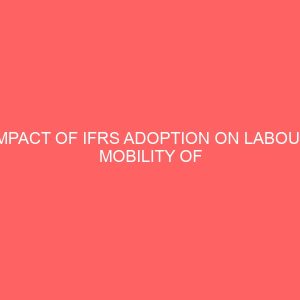Description
ABSTRACT
This research work, the researcher examined the growth and contribution of life assurance business in Nigeria. The information for the study was collected using primary and secondary methods of data collection. For the primary data collection, questionnaire was used while existing literature relevant to the topic was consulted for the secondary data. The sample size was determined using Taro Yamani formula the percentage method was used for data analysis while Chi-square statistical mode was used to test the formulated hypothesis. The researcher found out that Life assurance companies in Enugu specializes in life assurance business but they are experiencing inadequate patronage. Life assurance companies use brokers, agents and partially employed salesmen in marketing of life assurance policy to the insuring public. Based on the findings the researcher recommended that Government should establish insurance educational centers which should organize lectures, seminars, educational conferences and study programmes for the good of the public.
TABLE OF CONTENTS
Title page i
Approval Page ii
Dedication iii
Acknowledgement iv
Abstract v
Table of content vi
CHAPTER ONE
INTRODUCTION
1.1 Background of the Study 1
1.2 Statement of the Problem 4
1.3 Objective of the Study 5
1.4 Research Questions 6
1.5 Research Hypothesis 6
1.6 Significance of the Study 8
1.7 Scope and Limitations of the Study 8
1.8 Definition of Operational Terms 9
CHAPTER TWO
REVIEW OF RELATED LITERATURES
2.1 Concept of life assurance 11
2.2 types of life assurance policy 12
2.3 Importance/contribution of life assurance Business
in Nigeria economy 26
2.4 Factors affecting the growth and Contributions of
life assurance business in 31
2.5 Prospects of effective marketing of life Assurance
business in Nigeria 36
2.6 Various techniques of marketing life assurance
products in Nigeria 39
2.7 Strategies for marketing life assurance products in
Nigeria 41
2.8 The future of life assurance growth in Nigeria 43
Reference46
CHAPTER THREE
RESEARCH METHODOLOGY AND DESIGN
3.1 An Overview 48
3.2 Source of Data 48
3.2.1 Primary data 48
3.2.2 Secondary data 49
3.3 Population of the Study 50
3.4 Sample size and Sampling Techniques 51
3.5 Validity and Reliability of the Instrument 53
3.6 Method of data Presentation and Analysis 54
CHAPTER FOUR
DATA PRESENTATION ANALYSIS, DISCUSSION OF FINDING
4.1 An overview 56
4.2 Data presentation 56
4.3 Data Analysis 59
4.4 Testing of Hypothesis 69
4.5 Discussion of Findings 74
CHAPTER FIVE
SUMMARY OF FINDINGS, CONCLUSION AND RECOMMENDATIONS.
5.1 Summary of Findings 75
5.2 Conclusions 77
5.3 Recommendations 78
5.4 Suggestions for Further Studies 82
Bibliography 83
Appendix I 85
Appendix II 86
CHAPTER ONE
INTRODUCTION
1.1 BACKGROUND OF THE STUDY
The development of life assurance can be traced back to as far back as 1983. It was in this year that we have the first evidence of life assurance known today. A policy was taken on 18th June 1985 on the life of William Gibbons for a sum of 382. The contract was for twelve months and the money was to be paid if Gibbons died within twelve months. He did infact died on 8th may 1984. After a slight dispute over whether twelve months meant twelve calendar months, the money was paid (Nwite, 2007).
Olufawo (2005) states that, “today, we have thousand of life assurance policies issues in Nigeria in form of whole life assurance, endowment assurance, term assurance, joint life assurance etc. interestingly, in advanced countries, life assurance business has become the greatest area of investment because it even encourage savings.
Lerhari and Wesis (1974) state that, the advantage for policy owner is “peace of mind”, in knowing that the death of the insured will not result to financial hrardship for loved ones and lenders. It is possible for life assurance policy payouts to be made in order to help supplement retirement benefits.
In Nigeria, pension business was handled for many years by insurers until a group sold the idea of a contributory pension scheme to the government, which former scheme (old state scheme) where pensioners could not get their pension (benefit) after queuing for days led to the collapse of the old pension scheme.
The repeal of the old pension act of 1979 and consequential amendment of the Nigeria social insurance trust fund Act of 1993 brought in the new pension Reform Act 2004. Today, the pension fund has grown tremendously and is in excess of N1. 6 trillion, about 10times the premium of N164.5 billion recorded in the Nigerian insurance sector in 2008 (Fola, 2012).
In the present dispensation, the sector stands the chance to get boots from some of the statutory policies set for enforcement. The workmen’s compensation Decree of 1987 provided cover for permanent or partial disability, accident, sickness and death of worker arising in the course of their employment. Section 9(3) f the Act state that “employers shall maintain life assurance policy in favor of their employees for a minimum of three times annual total enrolment of the employee, under the group life scheme.
According to Aneke (2007) the pension Reform Act for 2004 delegate to the life in insurers, but their share of the fund depends on their ability to win the confidence of its huge population. Nigeria is the biggest life insurance market on the continent. He opined that, it the country’s life assurance business is well positioned it can attain a leadership position on the continent.
Therefore, it is against this background that this research study will investigates the growth and contributions of life assurance business in Nigeria.
1.2 STATEMENT OF PROBLEM
The following problems led to the formation of this research work;
a. Sub-standard policies designed by the underwriter’s could not meet the current change in the society towards satisfying individuals needs.
b. High rate of poverty that result to on interest or concern by the individuals has affected the development of life assurance policies Nigeria.
c. The low demand for life assurance policies has to greater extent affected the marketing of life assurance business.
d. Studies has shown that high rate of illiteracy is one of the major problems which affects the growth of life assurance business in Nigeria.
1.3 OBJECTIVE OF THE STUDY
In this study, the main objective is to examine the growth and contributions of life assurance business in Nigeria. The specific objectives of this research work include the following;
a. To examine the effects of sub-standard policies on the development of Life assurance business in Nigeria.
b. To find out the extent at which high level of poverty in the country affects the patronage of life assurance business.
c. To examine the effect of low demand for life assurance policies marketing of life assurance business
d. To examine the effect of illiteracy on the growth and development of Life assurance business in Nigeria.
1.4 RESEARCH QUESTIONS
a. What are the effects of sub-standard policies on the development of Life assurance business in Nigeria?







